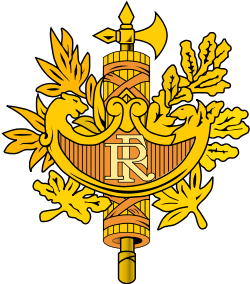French Union
| French Union | ||||||||||||||||||||||
| Union française | ||||||||||||||||||||||
| ||||||||||||||||||||||
| ||||||||||||||||||||||
| Motto "Liberté, égalité, fraternité" "Liberty, equality, brotherhood" | ||||||||||||||||||||||
| Anthem La Marseillaise | ||||||||||||||||||||||
| Capital | Paris | |||||||||||||||||||||
| Languages | French | |||||||||||||||||||||
| Political structure | State union | |||||||||||||||||||||
| Historical era | Cold War | |||||||||||||||||||||
| • | Fourth Republic | October 27, 1946 | ||||||||||||||||||||
| • | Fifth Republic | October 5, 1958 | ||||||||||||||||||||
| Currency | French franc CFA franc CFP franc French Indochinese piastre | |||||||||||||||||||||
| ||||||||||||||||||||||
The French Union (French: Union française) was a political entity created by the French Fourth Republic to replace the old French colonial system, the "French Empire" (Empire Français). It was the formal end of the "indigenous" (indigène) status of French subjects in colonial areas.
Composition
The French Union had five components:
- Metropolitan France, which included French Algeria.
- 'Old' colonies, notably those of the French West Indies in the Caribbean that became Overseas departments in 1946.
- 'New' colonies, renamed overseas Overseas territories.
- Protectorates of French Indochina. It had been expected that other protectorates would become part of the French Union, but the rulers of French Morocco and French Tunisia refused to become members and never belonged.[1] Only did.
- United Nations Trust Territories, such as French Cameroons and French Togoland, successors of the League of Nations mandates.
History
The French Union was established by the French constitution of October 27, 1946 (Fourth Republic). Under it, it was said that there were no French colonies, but that metropolitan France, the overseas departments, and the overseas territories combined to create a single French Union, or just one France.[2]
The goal of this union was "assimilation of the overseas territories into a greater France, inhabited by French citizens, and blessed by French culture."[3] The British colonial system had local colonial government which would eventually evolve into separate government; France wanted to create a single government under a single France.[3]
This French Union had a President, a High Council and an Assembly. The President was the President of the Republic. The Assembly of the Union had membership from the Council of the Republic, from the National Assembly and from regional assemblies of the overseas territories and departments but ultimately had no power.[4] The High Council ultimately only met three times, first in 1951.[5] The Assembly was the only actual functioning institution, wholly to be able to manage the legislation within the overseas territories.[3]
In reality, the colonial areas had representation but all power remained in the French Parliament and thus was centralized.[3] The colonies had local assemblies but these had only limited local power.[3] Instead, various natives of the overseas territories in metropolitan France grew into a group of elites, known as evolués.[3]
On January 31, 1956, hoping to having peace in Algiers, the system changed, abandoning assimilation in favor of autonomy, allowing territories to develop their own local government and to eventually gain their independence.[6] This would not succeed however and in 1958 the French Union was replaced by the French Community by Charles de Gaulle's Fifth Republic wherein France was now a federation of states with their own self-government.[7]
Withdrawals from the French Union
- Cambodia withdrew on 25 September 1955.[8]
- South Vietnam withdrew on 9 December 1955.[9]
- Laos withdrew on 11 May 1957 by amending its constitution.[10]
See also
References
- ↑ Charles-Robert Argeron, La décolonisation française, Armand Colin, Paris, 1994, p. 73.
- ↑ Simpson, Alfred William Brian (2004). Human Rights and the End of Empire: Britain and the Genesis of the European Convention. Oxford University Press. p. 285. ISBN 0199267898.
- 1 2 3 4 5 6 Simpson, Human Rights (2004), p. 286
- ↑ Simpson, Human Rights (2004), p. 285-286
- ↑ Simpson, Human Rights (2004), p. 286 fn. 33
- ↑ Simpson, Human Rights (2004), p. 286-287
- ↑ Simpson, Human Rights (2004), p. 287
- ↑ [ Displaying Abstract ] (2012-04-30). "CAMBODIA SEVERS TIES WITH FRANCE - Declares Her Independence - Prince Norodom Takes the Post of Premier - Article - NYTimes.com". Select.nytimes.com.
- ↑ "Pentagon Papers Part IV A 3" (PDF). 1954–1960.
- ↑ "Laos". Worldvisitguide.com.
Further reading
- Cooper, Frederick. "French Africa, 1947–48: Reform, Violence, and Uncertainty in a Colonial Situation." Critical Inquiry (2014) 40#4 pp: 466-478. in JSTOR
- Simpson, Alfred William Brian. Human Rights and the End of Empire: Britain and the Genesis of the European Convention (Oxford University Press, 2004).
- Smith, Tony. "A comparative study of French and British decolonization." Comparative Studies in Society and History (1978) 20#1 pp: 70-102. online
- Smith, Tony. "The French Colonial Consensus and People's War, 1946-58." Journal of Contemporary History (1974): 217-247. in JSTOR

